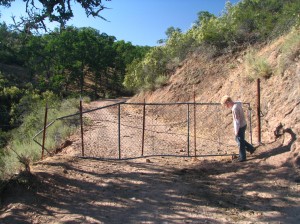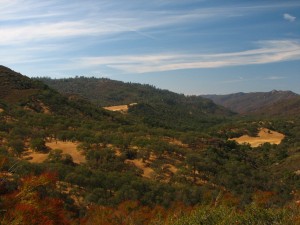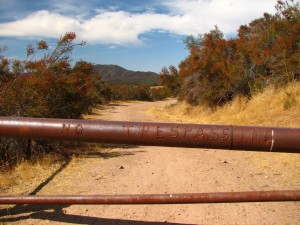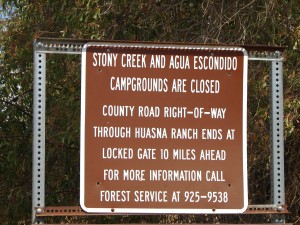ForestWatch Launches Effort to Restore Access
Huasna Valley, Calif. – For nearly one hundred years, the public has enjoyed access to thousands of acres of national forest land at the eastern end of this remote valley in southern San Luis Obispo County. But a neighboring landowner has blocked a public road that serves as the only access route into the area, prompting ForestWatch, local residents and forest users to band together in a massive effort to keep the route open.

A young Huasna Valley Resident and his family were recently turned away from a camping trip after finding this makeshift barricade across the road, blocking public access to campgrounds and hiking trails.
The road – known as Huasna Road – begins in the town of Arroyo Grande and passes through 25 miles of private farmland, ranches, and a historic townsite before reaching the oak-studded valleys and chaparral-covered hills in the Los Padres National Forest. For decades, visitors have flocked to the area’s two campgrounds at Stony Creek and Agua Escondido to enjoy springtime wildflower displays, unique rock outcrops, ancient Native American pictographs, abundant game, and access to hiking trails leading in all directions across thousands of acres of national forest land.
In the 1990s, the area was featured in California Coastal Byways: 50 of California’s Best Backcountry Drives, and has also been described in several hiking and mountain biking guidebooks and official Forest Service and USGS maps. The area’s trails provided the only publicly-accessible route into the southern Garcia Wilderness, and the road served as the only publicly-accessible route to the national forest between Hi Mountain Road and the Santa Barbara County line.
But today, public access to the area is blocked by gates and barricades that the Messer Land & Development Company has installed across several segments of Huasna Road. The road passes through the company’s vast property holdings before entering the national forest. Messer is a wholly-owned subsidiary of Queen City Investments in Long Beach, a corporation with assets exceeding $4 billion.
Since the 1940s, Messer and other landowners in the area have installed a series of gates across the road to restrict public access. Various forest user groups – hunters, hikers, campers, and equestrians – along with the Forest Service, the County of San Luis Obispo, and members of Congress, have tried unsuccessfully to negotiate a long-term solution with the landowner.
To permanently restore public access to the area, Los Padres ForestWatch is building a legal case in the event that a mutually-agreeable resolution cannot be reached with the landowner. Under longstanding California law dating back to the 1850s and affirmed several times by the California Supreme Court, a public right-of-way can be established by showing five years of continuous public use prior to 1972. If you visited this area prior to 1972, or know of people who did, see below to read about how you can help us restore public access to this area.
Huasna Road: The Early Days
The County of San Luis Obispo declared Huasna Road to be a public road in 1896, and has assumed maintenance responsibility for the road ever since. After Teddy Roosevelt established the area as a national forest in 1906, the U.S. Forest Service rebuilt the road in the 1930s using Depression-era crews from the Civilian Conservation Corps, who set up a formal camp near Stony Creek.
A World War II civil defense post known as the Avenales Observation Point was constructed in this area in the 1940s, accessed via Huasna Road by a husband-wife team who kept watch for possible enemy aircraft. Forest Service campgrounds have dotted the area since the 1930s, and the road has appeared as a publicly-open road on nearly every official Forest Service map produced since that time. The Forest Service regularly maintained the road inside the forest boundary.
“This road was built and maintained with taxpayer dollars for more than a century, and provides critical public access to national forest lands that are owned by the American people,” said Jeff Kuyper, executive director of Los Padres ForestWatch. “The public has enjoyed longstanding access to this area, and under well-established California law, we are all entitled to continue to enjoy this beautiful corner of the great outdoors.”
The Gradual Decline of Public Access

ForestWatch is working to ensure that the public can once again enjoy this beautiful view of Pine Ridge and the Stony Creek watershed in the Los Padres National Forest.
This corner of the Los Padres National Forest has been frought with battles over public access stretching back to the 1940s, when landowners first began placing gates across Huasna Road. By the 1960s, with the installation of additional gates along the road, the Forest Service grew increasingly concerned about the reduction of public access to the area. When one of these gates was installed across a County-maintained portion of Huasna Road, the San Luis Obispo County Road Department ordered the gate removed. In 1966, the Messer Land and Development Company filed a lawsuit to bar the County from removing the gate. The Court ruled in favor of the landowner, and the gate was allowed to remain in place.
The access battles flared again in the 1980s when Messer formally requested that the County abandon a 12-mile segment of Huasna Road that passes through the ranch. If the County abandoned the road, it would no longer be obligated to maintain it, and the public’s right to travel along the road would end. After receiving significant public testimony from various citizens and sportsmen’s groups wanting to preserve the public’s right to visit the area, the County Planning Commission unanimously denied the landowner’s request. The U.S. Forest Service attempted to acquire a permanent public easement in the area, but Messer rejected the idea, stating unequivocally that “it is not in our best interest to grant such an easement.”
In 1995, the U.S. Forest Service announced that the landowner had installed another gate, blocking vehicular access to Stony Creek Campground. Three years later, the landowner posted a “No Trespassing” sign on the gate and eliminated all public access to the area. Most recently, Messer installed another makeshift fence across the road with “No Trespassing” signs, barring the public from even more of the area. Recently, several long-time forest visitors and residents have been threatened with arrest while recreating here.
How You Can Help
ForestWatch hopes to negotiate a mutually-agreeable permanent right of public access to the Avenales Observation Point, the former Stoney Creek campground, and the trailhead leading into the southern Garcia Wilderness. However, if these negotiations fail, then we – along with a coalition of longtime trail users – are willing to go to court to uphold the public’s longstanding rights to access this area.
Under well-established California law, the public has an implied right of access across private land if it can be shown that the public traveled across that land continuously for five years or more before 1972.
People who have accessed this area prior to 1972, or know people who did, should contact ForestWatch at info@LPFW.org or (805) 617-4610 ext.1 to share your stories and help us build a strong case to restore public access. Old maps, photos, and other evidence showing public use prior to 1972 is also helpful.
Please consider making a donation to our Huasna Access Fund today. This is a long-term effort that will require a significant investment of time to research, negotiate an easement with the landowner, and potentially file a lawsuit if we’re unable to reach agreement. Donate to our Huasna Access Fund today so that we have the resources necessary to pursue this case.










Comments are closed.